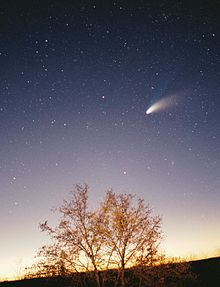The Asteroid belt is the region of the Solar System located roughly between the orbits of the planets Mars and Jupiter where a huge number of asteroids revolve around the Sun. These asteroids are also called minor planets. The asteroid belt region is also termed the main asteroid belt or main belt because there are other asteroids in the solar system such as near-Earth asteroids and trojan asteroids. More than half the mass of the main belt is contained in the four largest objects: Ceres, 4 Vesta, 2 Pallas, and 10 Hygiea. Ceres was thought of a an asteroid first, but later was subjected under dwarf planet, just like our Pluto. These have mean diameters of more than 400 km, while Ceres, the main belt's only dwarf planet, is about 950 km in diameter. The remaining bodies range down to the size of a dust particle.
The asteroid material is so thinly distributed that multiple unmanned spacecraft have traversed it without incident. Nonetheless, collisions between large asteroids do occur, and these can form an asteroid family whose members have similar orbital characteristics and compositions. Collisions also produce a fine dust that forms a major component of the zodiacal light. Individual asteroids within the main belt are categorized by their spectra, with most falling into three basic groups: carbonaceous (C-type), silicate (S-type), and metal-rich (M-type). Have you ever thought why Jupiter has so many moons? The answer lies in the Asteroid Belt. The asteroids revolving, are pulled by the super gravitational force of Jupiter. The pulled asteroid then revolves around Jupiter and slowly turns into a sphere.
Asteroids are left over materials from the formation of the Solar System. These materials were never incorporated into a planet because of their proximity to Jupiter's strong gravity.
Asteroids: Asteroids (from Greek ἀστήρ 'star' and εἶδος 'like, in form') are a class of small Solar System bodies in orbit around the Sun. Asteroids are the left over particles in space that didn't combine to form a planet. They have also been called planetoids, especially the larger ones.
Comets: A comet is an icy, small Solar System body. It displays a visible coma (a thin, fuzzy, temporary atmosphere) and sometimes also a tail when close enough to the Sun. These phenomena are both due to the effects of solar radiation and the solar wind upon the nucleus of the comet. Comet nuclei are themselves loose collections of ice, dust, and small rocky particles, ranging from a few hundred meters to tens of kilometers across. It is like they burn in vacuum. But the so called "shooting stars" must not be mistaken to these comets. A shooting star is considered by people to bring luck and also fulfill their wishes, but a comet is considered to be a bad omen.
 |
| A Shooting Star |









0 comments:
Post a Comment